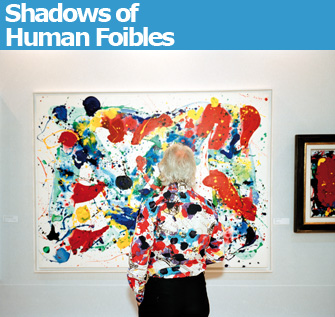 |
|
“United Arab Emirates. Dubai. DIFC Gulf Art Fair”
(2007), from the “Luxury” series. © Martin Parr, Magnum Photos/Kamel Mennour
|
Before you go to see the exhibition “Planète Parr. La Collection de Martin Parr” at the Jeu de Paume, I recommend that you look at a few books of Parr’s photos or check them out on Google Images, because …
 |
|
“United Arab Emirates. Dubai. DIFC Gulf Art Fair”
(2007), from the “Luxury” series. © Martin Parr, Magnum Photos/Kamel Mennour
|
Before you go to see the exhibition “Planète Parr: La Collection de Martin Parr” at the Jeu de Paume, I recommend that you look at a few books of Parr’s photos or check them out on Google Images, because this show is clearly directed at people who are already fans of his work.
And it’s hard to imagine that anyone who knows the work of this English photographer would not be a fan, for his marvelous sense of color, his ability to capture that Cartier-Bresson decisive moment and his social critiques (especially of the English lifestyle), which manage to be laugh-out-loud funny yet affectionate and not condescending (most of the time).
The Jeu de Paume show is not so much about his work, however, as about the inspirations for his work. Parr is a packrat and a collector of kitsch, and the exhibition presents part of his collections of postcards, watches, trays and an amazing array of trashy commemorative objects, notably relating to the September 11 terrorist attacks in New York. Who would have thought that so much investment had gone into manufacturing so many watches, statues, rugs, teapots etc. bearing images of Osama bin Laden and Saddam Hussein? There is also lots of Barack Obama memorabilia, including underpants and flip-flops decorated with his image.
By far the most interesting part of this rather disjointed show is Parr’s collection of work by other photographers, some of whose work may not be familiar to everyone but are well worth becoming acquainted with. These photos are clearly antecedents of Parr’s work in terms of themes – the often-gritty lives of ordinary people – and tone (ironic, witty, sometimes gloomy). There are some wonderful images here: Graham Smith’s “Gateshead” (1973), a moody, Hopperesque shot of a man with his back to the camera facing grim, treeless rows of identical houses, with an easy-to-miss girl standing in the doorway of one of them; Chris Killip’s “Skinningrove, North Yorkshire” (1981), a depressing view of a northern English beach destroyed by concrete and trash; Richard Billingham’s untitled image of a fat lady in a flowered dress whose colors and patterns are echoed in the jigsaw puzzle she is working and the extensive tattoos on her arms. The work of a few Japanese photographers, including a couple of terrifyingly evocative images by Jonanjima, is also shown, along with pix by many of the greats: Henri Cartier-Bresson, Robert Frank, Lee Friedlander, Garry Winogrand and William Eggleston among them. Parr’s extensive collection of photography books is displayed in cases.
Parr says he is interested in the “shadows of human foibles” that are “left behind after momentous and not so momentous events, or after world leaders are gone.” Perhaps that explains why his series “Luxury,” included in this show, is something of a disappointment. In these shots, Parr set out to show not what was left behind by the powerful but what the rich get up to when they get together at events where they feel at ease and can be themselves, like “The Millionaire Fair” in Moscow or the Art Basel contemporary art fair. While there are a few inspired images here – a man standing in front of a brilliantly colored splatter painting wearing a shirt with the identical pattern, for instance, or a woman’s hand with chipped red nail polish holding a glass filled with red cherries of the same shade – most of them don’t hit home in the way that most of Parr’s work does. Maybe because he doesn’t have the same sympathy for the rich that he has for the working classes? Or is it because the targets are too easy: rich people caught stuffing their faces in a most unattractive way at reception, for example, a pink satin dress with a stain on it stretched over a too-round stomach, or well-dressed women smoking big fat cigars, etc.
The only other glimpses we get of Parr’s own work in the museum itself are his series of photos of 10 British cities commissioned by the Guardian newspaper (only a small number of originals are on show; the rest can be leafed through in copies of the paper’s printed supplements) and three of his entertaining documentary videos, which reveal the sociologist in the photographer.
Why do we see so few of Parr’s own photos? Perhaps because Paris’ Maison Européenne de la Photographie mounted a retrospective of his work only a few years ago (in 2005). Parr collaborated with the curators on the Jeu de Paume show, as Annie Leibovitz did on her own recent retrospective at the Maison Européenne, and both cases make one wonder whether artist participation is always a good idea. Not that this is a bad exhibition – it is lots of fun and Parr’s collection of photographs is a must-see – but it doesn’t give the full picture of Martin Parr the photographer. Luckily, the Jeu de Paume is also showing 40 images of mass tourism from Parr’s “Small World” series, begun in the 1980s, in the Tuileries Garden.
Jeu de Paume: 1 place de la Concorde, 75008 Paris. Métro: Concorde. Tel.: 01 47 03 12 50. Open Tuesday, noon-9 p.m.; Wednesday-Friday, noon-7 p.m.; Saturday-Sunday, 10 a.m.-7 p.m. Closed Monday. Through September 27. www.jeudepaume.org
Buy related books and films from the Paris Update store.
More reviews of current art exhibitions.
Reader reaction
Click here to respond to this article (your response may be published on this page and is subject to editing).
© 2009 Paris Update
Favorite